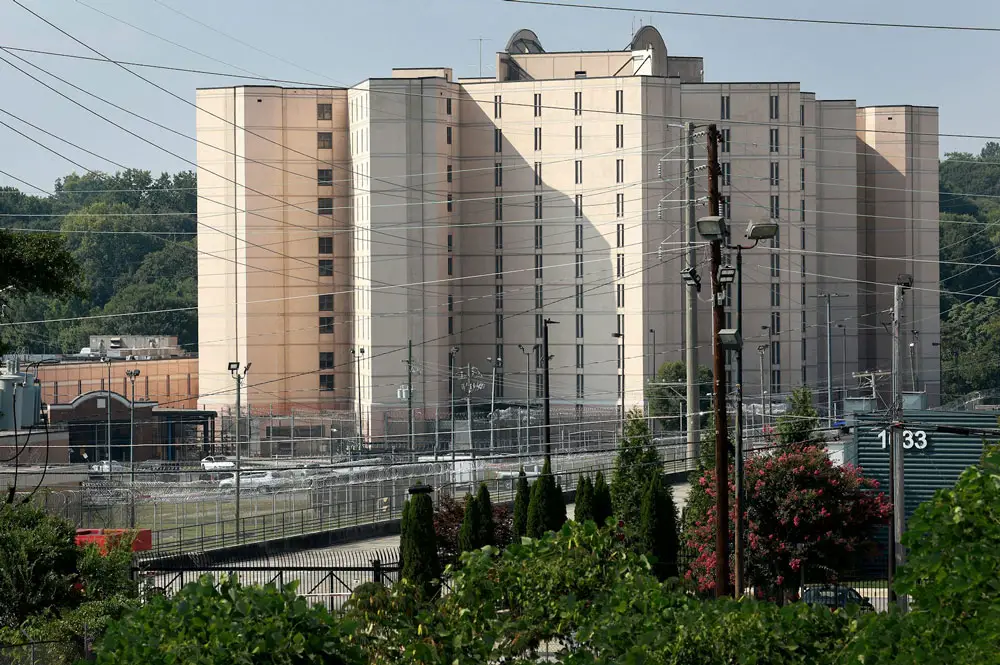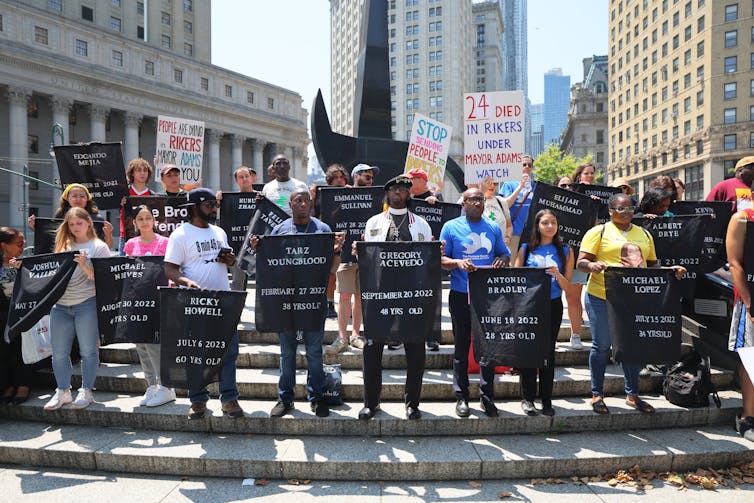
By Jessica L. Adler
The family of Samuel Lawrence, one of 10 people to die in Georgia’s Fulton County Jail in 2023, is fighting for answers and accountability.
“I got to think about him every day of my life and I don’t know when the pain stops,” Lawrence’s father, Frank Richardson, told a local TV station in October 2023. “I pray to God that he touches that jail and puts people in place to help the other ones that are left behind.”
Shortly before his death, Lawrence, 34, had filed a complaint about jail conditions, alleging that he was brutally beaten and isolated, with insufficient food and water.
But Fulton County Sheriff Patrick Labat largely blamed the jail’s “outbreak of violence” on “the long-standing, dangerous overcrowding and the crumbling walls of the facility.”
In order to “save lives,” Labat said, his county would be requesting a “replacement jail.”
The Georgia sheriff is among many law enforcement officials to claim that people like Samuel Lawrence would be safer if communities reduced overcrowding by building new jails or enhancing existing ones.
But recent research my colleague Weiwei Chen and I published on escalating jail mortality rates nationwide calls into question that rationale.
In an article published in the June 2023 issue of Health Affairs, we examined relationships between jail conditions and jail deaths, analyzing factors such as percent of jail capacity occupied, admission and discharge rates and population demographics.
Among the variables that appeared to be most significantly related to jail mortality were turnover rate – the number of people admitted to and discharged from a facility relative to its average population – as well as the percentage of Black people in the jail population.
Jail mortality
Jails are sometimes referred to as the “front door” of the criminal justice system. Unlike prisons, which are run by federal and state governments and hold convicted people serving relatively long sentences, jails are locally managed, and the majority of their populations are being detained pretrial while unconvicted.
Data on how many people die while incarcerated is notoriously inaccessible and often unreliable. Still, available reports on jail deaths from the Bureau of Justice Statistics offer some perspective.
In 2019, overall jail death rates were below the adjusted national average of 339 per 100,000, but leading up to that year, they had steeply increased. Between 2000 and 2019, jail mortality rose by 11%, from 151 per 100,000 to 167 per 100,000.

Michael M. Santiago/Getty Images
To conduct what epidemiologist Homer Venters referred to as an “apples-to-apples comparison” of circumstances and deaths in multiple jails during a period of escalating mortality, we relied on a combination of datasets.
For information about facility deaths, we turned to statistics compiled by Reuters news agency reporters, who submitted Freedom of Information Act requests to obtain mortality data from the largest jails across the U.S.
Our data on jail conditions – such as annual admissions and releases, facility capacities and demographics – came from the Bureau of Justice Statistics’ census and annual survey of jails.
Ultimately, we assessed mortality rates and conditions in approximately 450 U.S. jails between 2008 and 2019.
Some of our most robust findings about jail deaths had to do with two factors: turnover rate – the sum of weekly admissions and releases divided by average daily population – and demographics.
In the jails we examined, average turnover was 67% (slightly above the national average of 53%). Relatively high turnover rates, we found, were associated with higher death rates overall, as well as due to suicide, drugs and alcohol, and homicide.
In addition to revealing a relationship between turnover rate and mortality, our research showed that the presence of greater proportions of non-Hispanic Black people in populations of relatively large jails was associated with more deaths due to illness.
Race-based differences in illness-related deaths could be due to a variety of factors, including populationwide health disparities in the U.S.
Reliance on jails
Our findings about both turnover and racial disparities should be considered alongside the broader context of jail incarceration in the United States.
Roughly 4.9 million people are arrested and jailed each year, some of them multiple times. Overall, there were approximately 10.3 million admissions to more than 3,000 U.S. jails in 2019.
As of 2019, Black people were jailed at a rate more than three times that of white people.
People in jails have been found to be “significantly poorer” than people outside of jails, and more than 30 percent of those who are detained remain incarcerated because they cannot afford to pay bail.
Jailed people are also disproportionately likely to face health challenges. They are more likely to report having had chronic health issues, infectious diseases, mental illnesses and substance use problems.
The United States’ remarkably high population of incarcerated people – and the composition of that population – are related to decades’ worth of cuts in social welfare programs, structural racism, local and national political trends, and policing practices.
Research has shown that the cash bail system – a key driver of high jail turnover – “punishes the poor” by ensuring that they are more likely to be detained than their wealthier counterparts for the same crime. A reliance on cash bail also reportedly increases recidivism and undermines public safety.
Beyond incarceration
Our study suggests that ongoing initiatives geared at reducing incarceration – and by extension, jail turnover – could help achieve Sheriff Labat’s goal of saving lives.

Paras Griffin/Getty Images
Some communities, for example, have successfully limited the use of cash bail. Others have enhanced community-based services that address mental illness, drug use and homelessness without involving police, so jails are less likely to be sites of first resort for people with complex needs.
A year before Samuel Lawrence died, a report from the ACLU suggested that by adopting at least some of the above measures, Fulton County could “reduce its jail population significantly.”
It could also, our research suggests, save lives.
![]()
Jessica L. Adler is Associate Professor of History at Florida International University.





























Neighborhood Watch says
Part of the high incarceration in some states is based on individual state laws, which often vary greatly from other states. For example, in Florida, the change in crime classification for a “Text threat”, now a 2nd degree felony offense, punishable by up to 15 years. It’s classified with a terroristic threat. This change in crime classification was a reactionary aw change post the MSD high school mass shooting. In other states, this is a misdemeanor offense, with minimal incarceration.
This change has not only affected the time served for the crime itself, but also has impacted the criminal code scoring system, increasing the amount of points if a text threat is one of several crimes prosecuted. It can mean the difference between incarceration or a diversionary program or community supervision.
The review and overhaul of the criminal code in Florida and every state is necessary to ensure punishment fits the crime and provides a rehabilitation aspect to incarceration, rather than solely punishment.
LD says
Look into who provides the contracts for providing medical services. Jacksonville Pretrial Detention Center has a horrible record. Many of the jails across the country have the same companies providing medical services. These are companies with multiple lawsuits. All of my son’s 6 psychiatric medications were stopped cold turkey. One had the potential to cause a fatal rash if stopped or started at a high dose. It took a letter from an attorney to get him back on any medication. A previous inmate died about 3 days after being released for a misdemeanor. He had a heart transplant & begged for his medications while there to no avail. He died from a heart attack.
Atwp says
Black People are jailed at a higher rate than whites. Strange because there is a much higher population of whites than blacks. Common sense would say that it isn’t the crime but the white criminal system in this country. It will say that black people are targets. The system has always tried to keep black folks immobile. We are targets not because of our behavior sometimes but because of the color of our skin. Blacks do wrong but whites do more wrong because there is more of them. More white cops, more white judges, more white jail administrations will lead to more blacks in jail than whites. This is an anti black system that will never change. Black men you can’t help it because you are black but you can manage your behavior.
R.S. says
It’s ancient wisdom that poverty breeds crime. Now where are the economically disadvantaged folks in our society? Can you think that to its reasonable conclusion, Atwp?
The Geode says
“Black men you can’t help it because you are black but you can manage your behavior”. You said all that just to contradict yourself. Just because there are more people of one race doesn’t necessarily mean there will be more crime than a lesser race’s population. Japan is 98% Japanese and look at their crime rates. Stop blaming white people and start blaming this fucked up culture and mindset we seem to glorify.
Atwp says
Geode calm your nerves, don’t get mad because I’m telling the truth. More white judges, more white cops, than black judges, more than black cops. Stop being so blind and face reality you know I speak the truth. Please take the blinders off of your eyes and mind and face the harsh reality of racism.
Mary Fusco says
ATWP, here is a strange concept. Don’t commit criminal acts and you won’t have to worry about jails or judges. Funny, at 77 I have never been to jail or even been in a courtroom. I have 4 children and 5 children that have never once been in jail. And, we were not rich nor are we now. The truth and reality is that everyone has control over their destiny no matter what their race is. Give it a rest.
R.S. says
None of us has control over his or her destiny, methinks. Or if I did have complete control over my destiny, I would have owned a yacht, endless wealth, and lived in a mansion with all paid by someone else. And don’t tell me that if I had worked for it, I could have . . . . Only the very few who’ve managed to rig the system in their favor can do that and get away with it. In this country, it’s all a matter of the skin you’re in and the power you’ve got.
Atwp says
Mary do you have 4 children or 9 children?It is hard to let it rest when I see racism everyday. As a black man I just can’t let it rest, blacks people have let things rest for eons. Where did that get us? White people have did so much evil to black people and got little to no punishment, letting it rest isn’t the answer, we must fight back. I will not let it rest. I will fight the white man until I die. Letting it rest is being a coward fighting the white man show courage, and it show standing for what you believe in. I will not let it rest.
Atwp says
Mary, the second sentence in your comment sounds good. You say you are 77, that is great. As a black people msny have gone to prison and also died for crimes they didn’t do. Mary you should know I’m speaking the truth. Did you read about Black Wall Street? A white female lied and said a black male touched her. As a result the Black residence was bombed by the whites, they say 300 people died, mostly blacks if not all blacks. Remember Starbucks a few years ago, a whites woman called the cops on innocent black males. Remember the Central Park incident a few years ago, a white lady called the cops on a black man. We as Black People tending to our business and whites are calling the cops on us. Most of the time it is white women calling cops on Black Folk. We need to turn the table and start calling cops on the whites especially nosy white women. Mary the list is very long you are old read about some of the murders of black men by white cops. I don’t like white peoples.
R.S. says
On the other hand, you, Atwp, might remember Zora Neale Hurston’s line: Not all skinfolk are kinfolk. Perhaps you can also turn it ’round: Some kinfolk might not be skinfolk. Don’t throw out the baby with the bathwater by collective hate.
Mary Fusco says
You have made your dislike of white people pretty obvious. I don’t hate anyone. Your comment about me being old is offensive. If you outlive your hate, you too will be old one day. I’m sure you remember when blacks were setting their own neighborhoods on fire and looting businesses and destroying the lives of their neighbors. I can be snarky also. I truly hope one day you will realize that there is good and bad in every race. Not all whites are good and not all blacks are bad. Let that sink in.
Atwp says
Mary I didn’t intend to sound offensive, am sorry about that. As a black man I must continue to fight. I would like to reach that age and get older.
JimboXYZ says
8 billion plus for a global population, the system is a free for all, winners & losers in life are out of control. How many times does this have to be studied to draw the same conclusions really ? The human race is no better for pets. Dogs & cats will be euthanized just the same because people can justify that for abandoned & diseased animals. But it always comes full circle doesn’t it, what man kind does to man kind or anything really. The cost of incarcerating vs allowing the criminals to go back on the streets. When the criminal bonds out, they go back into full production, because that’s what they do for a living, why they got caught in the 1st place. A drug dealer/mule is going right back to their “job” & illegal business. If a few of them fall out in the process, as unfortunate for those individuals as it is for a demise, it’s just the nature & cycle of life. Take that mental case that opened fire in Flagler Beach vacation rental, he could’ve injured & killed another, granted he’s messed up, he’s never going to be right in the head. One almost sees this as instead of shooting the door & building up, he’s better off a suicide. And there is no shortage of parasites trying to fix the unfixable in that as overcompensated. That life, as horrible as this will sound, is never going to be a positive for the destruction & costs of trying to get that one to a natural old age death. If society will put a dog down for biting a child or biting too many children ? What’s different in a lot of these criminal cases. Take the Parkland shooter, there’s another analogous case of a dog that bit too many children. They stacked life sentences on him consecutively, like the stupidity of that even makes any sense. I think every family affected in the courtroom would have been just fine with a death penalty that day, or even now. As someone paying for it as a taxpayer, if they told me they decided to lethal inject the mass shooter, I really wouldn’t have an issue with that change in direction either. With some of the death row executions, those take 30+ years to finally getting around to doing that. Waste of money & resources really ?
R.S. says
According to ACLU data, about 70 percent of inmates in city and county jails are waiting for their trial date. I believe that local data place pre-trial inmates at about 65 percent. 25 to 30 percent of inmates are classified as Black, although only about 10 percent in the county are Black. [Hispanics and people classified as “white” inmates are significantly below their county-wide percentage.] I wonder what judges do all day so as to sit on a docket for as long as they do. An acquaintance in Volusia County has been waiting for three years on his trial in jail because he cannot make bail. And prison guards themselves suffer under the system, having an average life expectancy of 59 years according to a recent study.
We should learn from Scandinavian jails, where inmates are dealt with politely and kindly with education, not horror conditions. Scandinavian jails have a recidivism rate of 20 percent; ours have a recidivism rate of 70 percent. We have the death revenge; Scandinavians incarcerate none more than 25 years. And companies like JPay and Securus make a mint off the poorest segments of our population by monitoring for fees all the mail, the visits, and the email of inmates. To add insult to injury, the State charges $5.00 a day to inmates who are waiting on trial, I understand from inmates’ comments.
Atwp says
R.S. are Scandinavian jails that good or is this something they are telling people?
R.S. says
Why are we not sending our personnel there to find out and learn?! They are obviously miles ahead of us.
Atwp says
Are they?
Pogo says
@Jessica L. Adler, Associate Professor of History at Florida International University
Well said. Applies well to Emergency Departments of hospitals, aka, another door of jail/prison. And don’t forget the morgue.
The poor are there just to scare the shit out of the middle class.
— George Carlin
Related
A key insight into a keyhole view of the world
https://www.google.com/search?q=folger+adam+lock